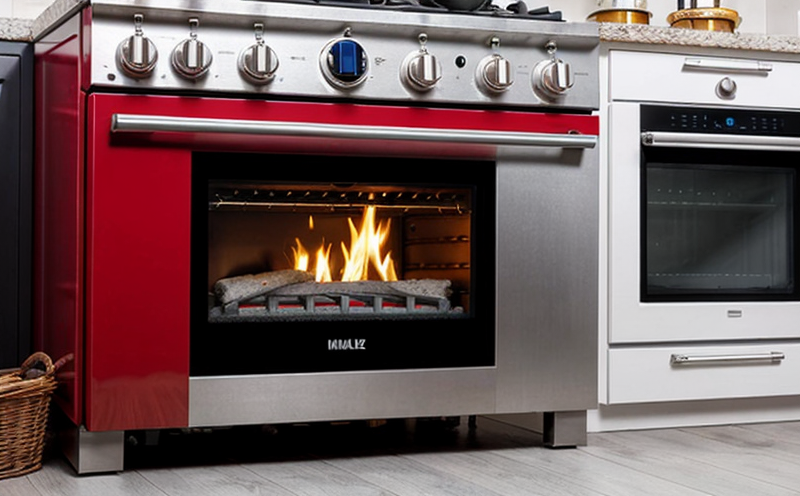UL 1026 Fire Safety Testing of Household Toasters
The UL 1026 standard is one of the most stringent and comprehensive fire safety testing standards for household appliances. This service is particularly critical for manufacturers of toasters, as it ensures that their products meet rigorous safety requirements that prevent potential fires and hazards in households.
UL 1026 mandates detailed procedures aimed at assessing the flammability characteristics of household appliances. The test involves exposing a toaster to various ignition sources while monitoring its behavior under controlled conditions. This process helps identify any potential risks associated with the appliance's design, materials, and manufacturing processes.
The testing criteria are designed to simulate real-world scenarios where an electrical fault or other issues could lead to fire incidents. By adhering to these standards, manufacturers can significantly reduce the risk of fires caused by their products. This not only protects consumers but also enhances a brand's reputation for quality and reliability.
The UL 1026 test involves several key steps, including pre-test inspections, sample preparation, exposure to ignition sources, recording observations, and post-test evaluations. Each step is meticulously documented to ensure compliance with the standard. The results of these tests are critical in ensuring that the toaster meets the necessary safety requirements.
Manufacturers who pass this testing can apply the UL mark, which signifies their adherence to high standards of quality and safety. This certification is highly valued by consumers and can significantly impact sales and brand perception. It also ensures compliance with local and international regulations regarding electrical appliances.
The UL 1026 test covers various aspects that could contribute to fire hazards in household appliances, including:
- Flammability of materials used in the construction of the toaster
- Electrical insulation integrity against short-circuiting and overheating
- Heat dissipation mechanisms to prevent excessive temperature buildup
- Design features that minimize fire risks during normal operation
The UL 1026 test is a crucial step in the product development lifecycle of any toaster manufacturer. By incorporating this testing into their quality assurance processes, manufacturers can ensure that their products are safe and reliable.
Understanding the scope and methodology behind this standard helps stakeholders appreciate its importance. The following table provides an overview of the key aspects covered by UL 1026:
| Aspect | Description |
|---|---|
| Material Flammability | Testing of materials for their flammability characteristics. |
| Electrical Integrity | Evaluation of electrical components to ensure they do not short-circuit or overheat. |
| Heat Dissipation | Assessment of the toaster's ability to dissipate heat effectively. |
| Design Features | Evaluation of design elements that minimize fire risks during normal use. |
Scope and Methodology
The UL 1026 standard specifies detailed procedures for testing the fire safety of household appliances, including toasters. The test involves exposing a toaster to various ignition sources under controlled conditions to assess its flammability characteristics.
The scope of the test includes:
- Pre-test inspections to ensure the toaster is in good condition
- Sample preparation for testing
- Exposure to ignition sources, including electrical sparks and hot surfaces
- Recording observations during and after exposure
- Post-test evaluations to assess any fire-related issues
The methodology used in the test is designed to simulate real-world scenarios where an electrical fault or other issues could lead to a fire. By following these procedures, manufacturers can ensure that their products meet the necessary safety requirements.
Key aspects of the UL 1026 test include:
- Evaluation of the toaster's material properties
- Assessment of electrical insulation integrity against short-circuiting and overheating
- Testing of heat dissipation mechanisms to prevent excessive temperature buildup
- Analysis of design features that minimize fire risks during normal operation
Quality and Reliability Assurance
The UL 1026 standard plays a vital role in ensuring the quality and reliability of household toasters. By adhering to these standards, manufacturers can significantly reduce the risk of fires caused by their products.
This service is particularly important for quality managers and compliance officers who need to ensure that their products meet high safety standards. R&D engineers also benefit from this testing as it helps them identify potential risks early in the product development process.
The UL 1026 test provides a comprehensive evaluation of various aspects of the toaster's design, materials, and manufacturing processes. This ensures that the product is safe for use in households. The results of these tests are critical in ensuring compliance with local and international regulations regarding electrical appliances.
By incorporating this testing into their quality assurance processes, manufacturers can ensure that their products are safe and reliable. This not only protects consumers but also enhances a brand's reputation for quality and reliability. The UL mark signifies adherence to high standards of quality and safety, which is highly valued by consumers and can significantly impact sales and brand perception.
International Acceptance and Recognition
The UL 1026 standard is widely recognized and accepted internationally. This makes it an essential requirement for manufacturers aiming to export their products to various markets around the world.
Many countries have adopted standards similar to UL 1026, recognizing its stringent requirements for fire safety testing of household appliances. Compliance with this standard ensures that products meet local and international regulations regarding electrical appliances.
The UL mark is also highly valued by consumers, who increasingly demand products that are safe and reliable. This certification can significantly impact sales and brand perception, making it an important consideration for manufacturers.
By adhering to the UL 1026 standard, manufacturers can ensure their products meet high safety standards. This not only protects consumers but also enhances a brand's reputation for quality and reliability. The UL mark signifies adherence to these high standards of quality and safety, which is highly valued by consumers.





